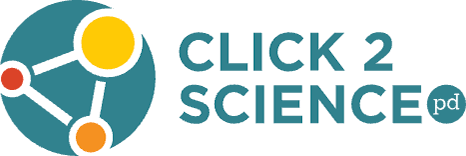Finding the Best Trainer for Your Program
This week’s blog on the who, what, why, and how of professional development will help you decide who can provide the professional development for your staff. The Click2Science professional development model is designed to build local capacity for STEM. It is flexible to meet your program requirements and integrates the resources you have available. I will examine four different models so you can implement the one that best fits your program.
Providing Training in Your Own Program
The easiest and most effective solution is for your local site director to provide training for the staff they work with everyday. When professional development is local, it reduces travel costs and time spent in training, but there are drawbacks. Consider these advantages and drawbacks to determine if this model is best for your program. Tips and support on Click2SciencePD can help local leaders prepare to lead professional development.
Advantages
- Easy to fit training into your schedule
- Low cost for training
- Staff can support one another in improving practice
- Works well to incorporate reflection on practice
- Local trainer can provide on-going support and feedback to staff
Drawbacks
- Site directors may not have expertise in training
- Coaching staff may contradict site director’s role as a supervisor
- Small groups make collaborative activities more challenging
Local Training Different Programs in Your Community
A local program leader can bring together staff from many programs in your community in a training experience. This model provides unique opportunities for community-wide impact. It maintains cost-savings of local professional development, but broadens the impact of the effort. By collaborating together, local programs can learn from one another and provide positive impacts to their community. This option builds upon local resources to address local needs. Using the tips and support from Click2SciencePD, you can develop the capacity for high quality STEM in your community.
Advantages
- Multiple perspectives optimize opportunities for social learning
- Staff can work together to implement the skills they are developing
- Local trainers are less expensive
- Efficient use of training efforts
Drawbacks
- Requires coordination between multiple programs
- Local program leaders may not have expertise in training
Using Experts within Your Community
Partners from your local community bring the voice of the expert to your professional development experience. They also have a local understanding of the challenges faced by out-of-school programs in your community. Connect with state afterschool networks, local colleges, museums, science centers, schools, or 4-H programs to find experts who can provide training. Local trainings provide opportunities to network with other programs and find new resources. These experiences introduce your staff to new perspectives and experiences. Click2SciencePD has resources to support you in connecting to community partners.
Advantages
- Provides opportunities to hear different points of view
- Utilizes strengths within your community
- Ideal for social and experiential learning
- Local experts may be able to provide ongoing support and follow-up
Drawbacks
- Requires coordination between multiple agencies
- Requires time away from your program
- May not be focused on the specific needs of your staff
Click2Science National Trainers Bring New Experiences
There are times when an external voice and expert is just what your program needs to excel. In this case, you may want to find a Click2Science trainer who can come provide the trainings you need. National trainers can help you and your staff understand national research and trends. They can share solutions from other programs and introduce new ways of thinking. Click2Science offers a variety of customized services to meet your needs.
Advantages
- An experienced facilitator will enhance the learning experiences
- Experts provide new points of view and research-based solutions
- High-quality professional development experiences energize staff
Drawbacks
- External experts can be costly
- National experts may focus on general rather than local needs
- On-going support and follow-up from an outside expert will be limited
For help getting connected with a Click2Science trainer, contact us at Click2SciencePD@unl.edu.
I want to emphasize that all four options can have positive impacts on your staff and program. Research by Click2Science and others in our field has shown that each of these models can have positive impacts on program quality, staff retention, and outcomes for youth. I’ve shared he advantages and disadvantages of each options o you can make the best decision for your program.
Join the Conversation
- What are your thoughts on these different models?
- What has worked for you?
Tell us in the comment section below!

